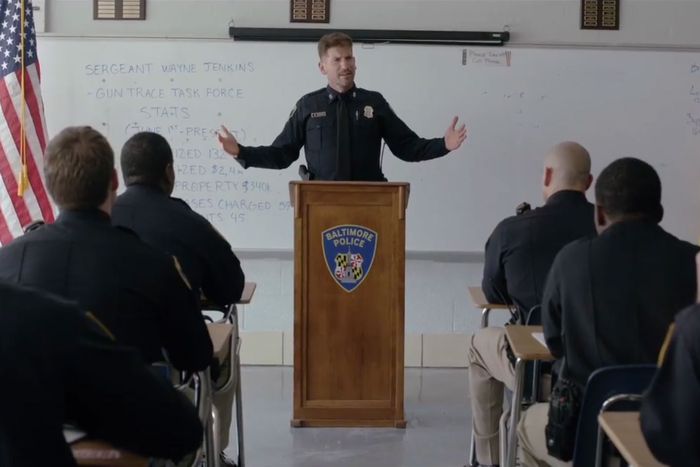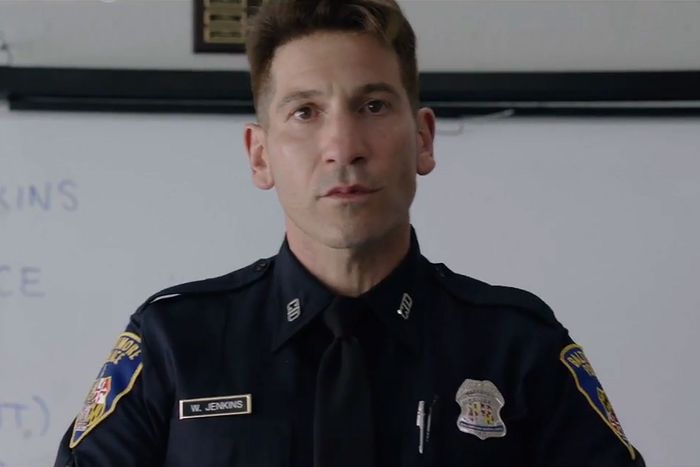
“The city of Baltimore is a poster child for the basic failure to stop lawlessness,” says Maryland governor Larry Hogan in the opening credits of We Own This City, and there’s a smirking bent to the series’ decision to feature that quote in each of its six episodes. The line is from an October 15, 2021, press conference during which Republican Hogan refused calls to defund the police and instead announced a $150 million package intended as “a desperately needed shot in the arm” for Maryland police agencies. “To reverse the tide of rising crime, we need to stop demonizing and sabotaging the dedicated men and women who risk their lives every single day to keep the rest of us safe,” Hogan continued in that speech, a grimly ironic statement juxtaposed with the subject of We Own This City.
For years, members of the Baltimore Police Department Gun Trace Task Force had run roughshod over citizens, stole hundreds of thousands of dollars in cash and millions in drugs, framed people for crimes they hadn’t committed, and caused the death of a bystander during an unnecessary car chase. And they did it all while collecting praise from their colleagues and bosses, more resources from the department, and millions of dollars in overtime — often more than their annual salaries. The dehumanization and sabotage of which Hogan speaks didn’t affect GTTF’s members but were inflicted by them on the people they were supposed to be protecting.
The six episodes of George Pelecanos and David Simon’s HBO miniseries, adapted from the nonfiction book of the same name by Justin Fenton, never lose sight of that betrayal. And in the finale episode, “Part Six,” an unnerving, pretentious speech from Jon Bernthal’s GTTF sergeant Wayne Jenkins drives home We Own This City’s guiding thesis with jarring clarity. The moment is a reimagining of an earlier scene from “Part 1,” in which Jenkins — seemingly a successful hero cop who puts guns and drugs on the table, a valuable quality in the aftermath of the killing of Freddie Gray — gives a speech to police cadets about the value of intelligence and patience in police work instead of brutality and violence. In this closing spin on that moment, Jenkins is giving his speech not to officers in training, who look upon him with distant respect, but to all the other officers, underlings, and bosses he has served with over the course of the season, and they’re all cheering him on, clapping and yelling and embracing him as one of their own. In tandem, the pair of scenes argues that the GTTF was a symptom of flawed police work rather than an aberration, and the echo chamber that enabled such immorality, greed, and self-justification remains in place.
By opening and closing with Jenkins, the miniseries centers him as both the ringleader of the GTTF’s bad behavior and an utterly ordinary product of the department’s self-aggrandizing culture. Perhaps aware of how much the culture has changed since The Wire — one of Pelecanos and Simon’s many TV partnerships —We Own This City complicates cop worship from the beginning. The first six minutes of “Part 1” are divided into two timelines (a device the show uses throughout to jump between 2003 and 2018) that initially seem to present Jenkins in the way he would want to be seen. On January 10, 2017, while giving that in-service talk to cadets, he’s a little self-deprecating and a little bit funny, with that customary Bernthal blend of goofiness and smugness.
He says things like “If we lose the fights, we lose the streets,” which is fearmongering, but he follows that up with “That kind of brutality, it only gets in the way of you doing the job,” because Jenkins wants cops to do the job right. This whole speech is a collage of self-justification, with the good veteran telling the green newbies how to honor “wearing the badge.” Bernthal is shot from behind and above the cadets to reinforce his position of authority.
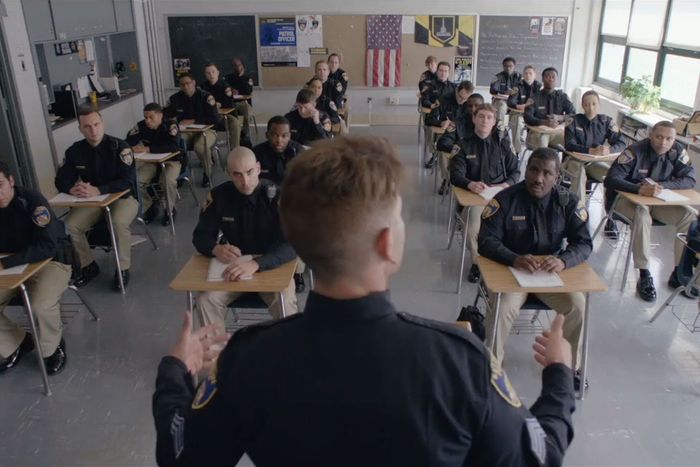
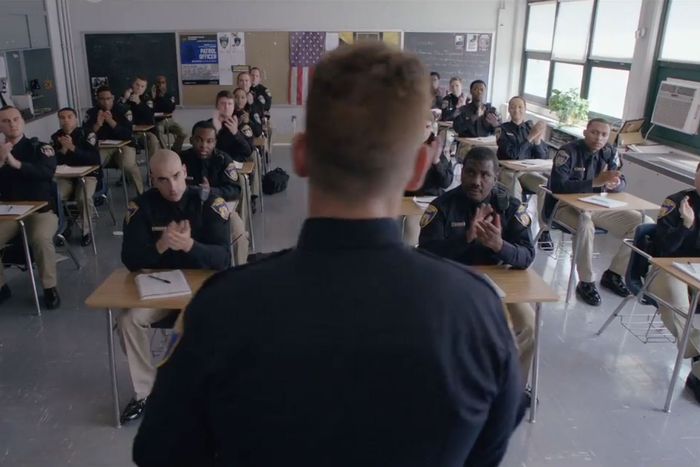
But director Reinaldo Marcus Green undercuts that encouragement by cutting to Baltimore street scenes that show the truth of the job. When Jenkins says, “You ain’t doing jack by being brutal,” we see officers shoving suspects up against walls. The line “Gun Trace Task Force, we are not about that bullshit” is juxtaposed with a line of Black men staring into the camera, their hands behind their backs. And when Jenkins is applauded for saying “You can’t lose. Now go out there and give them hell,” we flash back to an early day on the job when, as a beat cop, Jenkins smashed the liquor bottle of a Baltimore citizen minding his own business. That uniform, that wooden baton, and that badge give Jenkins power to spread fear without accountability, and we know if he makes “the report read clean,” no one will question his needless assault on that man — or anyone else.
With that framework in place, We Own This City follows a number of overlapping narratives. There are the antics of Jenkins and other Baltimore cops, some of whom are part of the GTTF and many of whom are dirty. They attract the attention of some county cops, who eventually loop in the FBI and help launch an investigation into the GTTF, including into its connections with local drug dealers. Meanwhile, the Department of Justice’s Office of Civil Rights has been deployed to work on a consent decree that could change policing in the city in the wake of media coverage of the millions Baltimore paid out to settle lawsuits against officers for undue force. These threads are brought together via interviews with members of the GTTF, and this frame organizes Jenkins’s deviousness and lawlessness, contextualizes how he got that way, and explains how he could operate as he did for so long. When Fenton appears as himself in “Part Six” and asks Delaney Williams’s Police Commissioner Kevin Davis, “Shouldn’t the leadership of the police department have known?” he speaks for all of us — and sets up the episode’s final scene, which, through Jenkins’s fantasy, objects to his colleagues’ deniability.
The miniseries’ closing minutes come after a series of intertitles that lay bare the corruption and tragedy festering throughout Baltimore’s criminal-justice system and its highest levels of government. Jenkins refuses to cooperate with the FBI; pleads guilty; gives a teary, inauthentic apology in court; and is sentenced to 25 years in federal prison. Most other members of the team get less for offering information. Davis is fired by Mayor Catherine Pugh and replaced with new commissioner Darryl DeSousa, who reinstates the plainclothes units that do so much harm to the city. Four months later, he is convicted for federal tax evasion; a year later, Pugh pleads guilty to conspiracy, tax evasion, and fraud, and is sentenced to three years. The crime rate explodes. Police misconduct persists. And with all that systemic malfeasance established, “Part Six” returns to Jenkins, who, while standing alone in the prison yard, revisits in his mind that in-service speech.
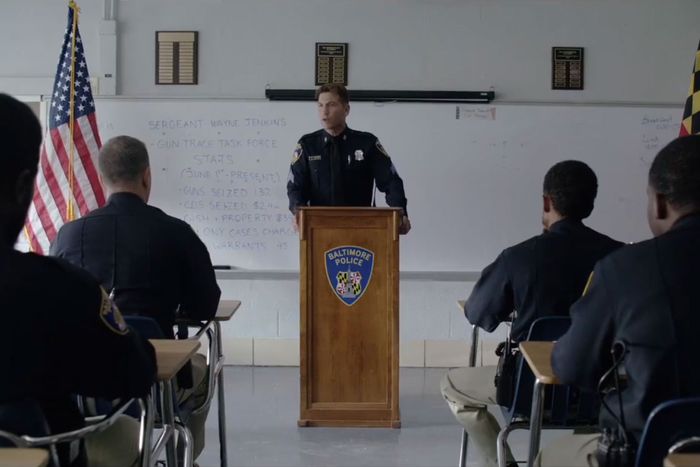
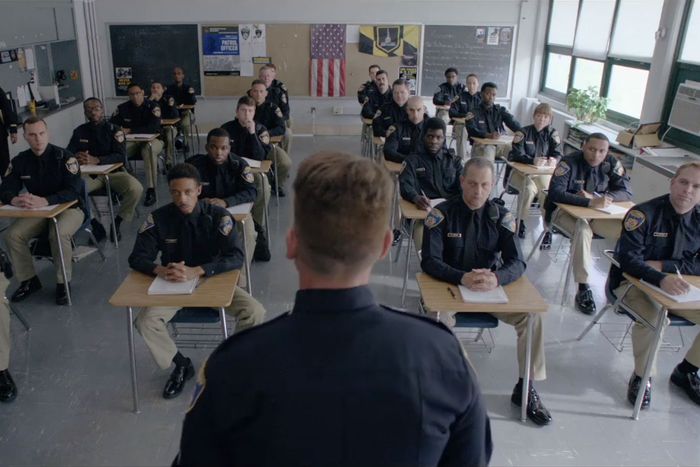
Although the text of the speech and Bernthal’s framing begin the same way, a look around the room reflects how Jenkins sees himself: as a champion to those who trained him and those he trained. The men who covered for Jenkins are here, such as Sergeant Michael Fries (Joey Palestina), who laughed off a complaint from a man Jenkins had attacked when he was sitting on his own front stoop, and Deputy Commissioner Dean Palmere (Christopher R. Anderson), who fought back a grin at Jenkins’s defense of fellow officer Fabien Laronde, who was finally fired after years of misconduct complaints. The men Jenkins corrupted are here too, including Jamie Hector’s homicide detective Sean Suiter, whose death remains mysterious (and is the subject of The Slow Hustle, a documentary directed by The Wire alumna Sonja Sohn), and Rob Brown’s Maurice Ward, who threw away $20,000 in stolen cash because Jenkins and the GTTF were stealing at such a fast rate he couldn’t come up with an explanation to give his wife about where all the money was coming from.
We watched as each of these officers did something, or many things, that were illegal or immoral over the course of We Own This City, and in this room, they emerge as a kind of totality. (Note that neither the Baltimore nor Harford County cops who help the FBI, nor the young city beat cop played by Jermaine Crawford in “Part 3,” appear before Jenkins here.) Green frames the men mostly alone at their desks in centered, crisp close-ups, their eyes adoring, their expressions beatific, and they mirror back at Jenkins what he still believes about the righteousness and worthiness of the police. But We Own This City is pushing the contradiction of it all: the cops in their neatly pressed uniforms with all the stolen goods stashed in their homes and the bloodstains on their hands. The warped impact of the first version of Jenkins’s speech curdles past satire and into cynicism as the whole audience gets up to zealously cheer. Josh Charles’s Daniel Hersl — a cop so well known in Baltimore for his racism that local musician Young Moose rapped about his antics — stares directly into the camera while pointing at Jenkins and at us. And when Jenkins wades into the rows of desks, his body is surrounded by those of his comrades as they shield him as effectively as the BPD badge that hid their misdeeds for so long.
Is this scene how Jenkins delusionally remembers that day, or how he deliberately imagines it? The distinction may not matter. Bernthal’s almost wistful line delivery of “That’s the job” practically breaks the fourth wall, and the certainty of his tone links all the protections the GTTF were afforded with all the crimes they committed. A system that allows for the former provides the opportunity for the latter, and the lingering impact of We Own This City is one of effectively sprawling bleakness.
“The city of Baltimore is a poster child for the basic failure to stop lawlessness,” Hogan says in the series’ title sequence, but Jenkins’s bookended speeches about what the job of a BPD officer was once supposed to be versus what it has become are a sobering reminder that this Charm City era isn’t over. The collective failures of Jenkins and so many others continue to reverberate outward, to affect the relationship between Baltimoreans and the BPD (many of whom don’t live in the city), and to reflect how, in the parlance of The Wire, all the pieces matter. “I’m proud of you,” Jenkins says to his BPD colleagues in that room, but We Own This City, rightly, isn’t so forgiving.



